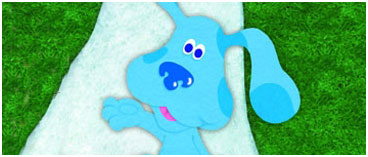

Click here to find out when it's on
Meet the Creators
Why do kids love Blue’s Clues? Because the show “empowers, challenges, and builds the self-esteem of preschoolers while making them laugh,” according to Dr. Alice Wilder, director of research for Blue’s Clues.
We caught up with Alice and show creator Angela Santomero to ask them what else makes Blue’s Clues so special.
How did you come up with the idea of Blue's Clues?
Angela: I was working as a freelancer for Nick Jr. and we were thinking of something like a game show for preschoolers. Something where they could learn through play. So Traci Paige Johnson, Todd Kessler, and I talked about breaking some of the rules for what was out there in preschool TV. There’s something to be said for talking directly to the audience. So we came up with the concept of a real person living in an animated world and having a smaller animated character that could help you with the game play.
Why a puppy?
Angela: Initially we had a kitten, but we heard that another program was in the works that had a kitten, so we switched to a puppy. We made her a girl because we wanted the animated character to be the opposite sex of the live character. Since we always had the live character working off of a blue screen, we decided to call her Blue. We consciously went against the color stereotype.
How does the show improve self-esteem?
Alice: We use a multilayered approach. In every episode the learning concepts become more difficult. We start them off with concepts that preschoolers can easily grasp. Once they get the hang of it they can try something more difficult. They also achieve mastery through repetition. We find that the kids might not understand everything on Monday, but by Friday they will.
Angela: The interactivity gives kids a voice. Joe asks kids for their opinion and help. That doesn’t happen a lot with preschoolers.
How does finding clues help kids learn?
Angela: Clues are a way kids can solve problems. If Blue has a problem that needs to be figured out, you have to pay attention to the entire episode. Each clue narrows the problem down for the kids, and they have to think carefully to solve it. Having them write down each clue is an educational message. They’ll need to write things down as adults.
Can you talk about the interactivity that kids experience while watching Blue's Clues?
Alice: Joe asks the preschoolers questions and then waits for an answer because he can’t go on without their help. We’ve done a lot of research to see how kids respond to these questions. One hundred preschoolers view every episode, and we pay attention to their responses.
Angela: One of the biggest things we believe in is that TV can be active. There’s stuff going on in children's heads while they're watching the show. Especially when kids are moving around all the time. We say things slower than most shows to help the kids grasp everything.
We’re very aware of the research on negative effects of TV. We turn that research on its head. Since kids emulate what they see on TV, we give them something positive to imitate and respond to. It blew me away when we showed the program to kids, and they all screamed when a clue came on.
What makes Blue's Clues so different from other children's programming?
Alice: We pay close attention to something called “Situated Cognition.” We believe that to preschoolers, the ordinary is extraordinary. We take the moments in preschoolers’ lives. That’s why we dedicated an entire show to snack time. Now, an adult might think that 22 minutes on snack time is extreme, but it’s a huge part of a preschooler’s life.
Angela: Our entire approach is a little different. Oftentimes, when people write for educational TV, they write the show and add in educational moments or vice versa. We do both at the same time, and it makes a huge difference.
What are some of the different themes and topics the show addresses?
Angela: We run the gamut of prosocial stuff. New neighbors. New friends. "Blue’s Sad Day." We deal with issues and problems that the children would face. We also take on subjects that are beyond traditional preschoolers. We’ll address anatomy, geography, and even physics. We take bigger themes and break them down to something they can grab on to. Everything starts from this foundation.
How long does an episode take to make?
Alice: It usually takes 9 to 10 months per episode. That includes research, writing, storyboarding, design, and animation.
How does the show address the needs of parents? Does it reinforce any specific goals?
Angela: We are constantly making sure that there’s something for many age groups. Two to five is a large gap to program for, and we’re aware of that. We find that parents model Joe’s behavior. They see how he talks to kids. He doesn’t talk down to them. Parents also see everything can be a learning opportunity—even going to the grocery store.
How can parents build on what their child learns on the show?
Angela: Parents, from what we understand, do a lot of co-viewing. They can answer questions during the show. Parents can reinforce the games and songs that teach the children. Teachers will use the show to help compliment their curriculum whether it’s teaching about colors or counting. Any parent can do the same.
|